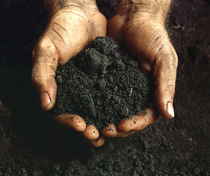Oregon State Soil
Jory Soil

(Fine, mixed, active, mesic Xeric Palehumults)
Adopted in 2011.
A nearly twenty-year effort by the Oregon Soil Science Society culminated in the legislature designating Jory soil as a state symbol. The society unofficially adopted Jory soil in 1993 as part of a nationwide effort by soil scientists to recognize soil's importance for agriculture and the environment. Members aligned with state representative Mitch Greenlick and with Richard Page, a descendent of the Jory family for which the soil was named. After a failed 2007 attempt, Greenlick ensured approval in 2011 by threatening to block unrelated legislation.
USDA soil scientists first identified the soil in 1970 on Jory Hill, which was named for 1847 Marion County pioneers James and Mary Jory. The red soil largely came from ancient volcanic basalt flows that originated in eastern Oregon. In the Willamette Valley, the rock weathered into a deep soil that drains well and is optimal for growing Christmas and filbert trees, berries, and other crops.
Oregon State Soil: Jory Soil
 The Jory series consists of very deep, well-drained
soils that formed in colluvium derived from basic igneous rock. These soils are in the foothills surrounding the Willamette Valley. They have been
mapped on more than 300,000 acres in western Oregon. They are named after Jory Hill, Marion County, Oregon.
The Jory series consists of very deep, well-drained
soils that formed in colluvium derived from basic igneous rock. These soils are in the foothills surrounding the Willamette Valley. They have been
mapped on more than 300,000 acres in western Oregon. They are named after Jory Hill, Marion County, Oregon.
Jory soils generally support forest vegetation, dominantly Douglas fir and Oregon white oak. They are very productive forest soils. Many areas have been cleared and are used for agricultural crops. The Jory soils and the climate of the Willamette Valley provide an ideal setting for the production of many crops, including Christmas trees, various berries, filberts (hazelnuts), sweet corn, wheat, and many varieties of grass seed. The soils are suitable for the grapes used in the expanding wine industry.
Growing urbanization of the Willamette Valley is resulting in a great deal of pressure for development in areas of the Jory soils.
Jory Soil Profile
Surface layer: organic material
Subsurface layer: dark reddish brown silty clay loam
Subsoil - upper: dark reddish brown clay
Subsoil - lower: red clay
JORY SERIES
The Jory series consists of very deep, well drained soils that formed in colluvium and residuum derived from sedimentary and basic igneous bedrock. They are on foothills and have slopes of 2 to 90 percent. The mean annual precipitation is about 45 inches and the mean annual temperature is about 53 degrees F.
TAXONOMIC CLASS: Fine, mixed, active, mesic Xeric Palehumults
SERIES ESTABLISHED: Benton County (Benton Area), Oregon, 1970.
76th Oregon Legislative Assembly - 2011 Regular Session
Enrolled
House Concurrent Resolution 3
Sponsored by Representative GREENLICK (Presession filed.)
Whereas soils produce food and fiber, recycle water, support
lush forests, yield bountiful grain and nut harvests, provide
range forage, sustain wildlife and foster urban development; and
Whereas the State of Oregon and its citizens benefit from a
rich and diverse soil resource that sustains agricultural, range,
forestry and urban economies; and
Whereas public awareness of Oregon's soil resource promotes
land stewardship and soil conservation, which benefit future
generations; and
Whereas Oregon has many unique soils due to interactions of
complex geology, varied climates and diverse biota; and
Whereas the various soils provide color, texture and patterns
to Oregon's landscape; and
Whereas Jory soil is easily distinguishable by its strikingly
red color on stable foothills; and
Whereas Jory soil exhibits distinctive characteristics and
features that illustrate soil formation, conservation and
management; and
Whereas Jory soil is representative of Oregon's diverse and
unique soil resource; now, therefore,
Be It Resolved by the Legislative Assembly of the State of
Oregon:
That we, the members of the Seventy-sixth Legislative Assembly,
designate Jory soil as the official soil of the State of Oregon.
----------
Adopted by House March 30, 2011
----------------------------------
Ramona Kenady Line, Chief Clerk
of House
----------------------------------
Bruce Hanna, Speaker of House
----------------------------------
Arnie Roblan, Speaker of House
Adopted by Senate May 23, 2011
----------------------------------
Peter Courtney, President of
Senate
Oregon Law
The law designating Jory Soil as the official Oregon state soil is found in the Oregon Revised Statutes Edition, Title 19, Chapter 186
Vol. 5 State Government, Government Procedures, Land Use
Title 19 Miscellaneous matters related to government and public affairs
Chapter 186 State Emblems; State Boundary
Official Designations
Jory Soil Designated As Official Soil, Hcr 3 (2011)







